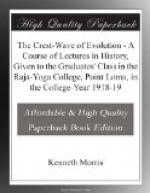So Sassanian history is, on the whole, uninteresting. Their culture stood for no great ideas; only for a narrow persecuting church. West Asia was not ready yet for great and world-important doings; it must wait for these till Mohammed, who struck into the very least promising quarter of it, and kindled in the barbarous wilderness a light to redeem the civilization of the western world. I shall hardly have to turn to the Sassanians again; so will say here what is to be said. We have seen that their empire was quite unlike the Parthian; it was a reversion to, and copy in small of, the Achaemenian of Cyrus and Darius. It never attained the size of that; and only late in its existence, and to a small degree, overflowed the Parthian limits. But it was a well-organized state, with a culture of its own; and enough military power to stand throughout its existence the serious rival of Rome. Its arts and crafts became famous, —thanks largely to Mani; in architecture it revived the Achaemenian tradition, with modifications of its own; and passed the result on to the Arabs when they rose, to be the basis of the Saracenic Style. There was a fairly extensive literature: largely religious, but with much also in belles lettres, re-tellings of the old Iranian sagas, and the like. Its history is mainly the record of gigantic wars with Rome; these were diversified later by tussles with the Turks, Ephthalites or White Huns, et hoc genus omne. Its whole period of existence lasted from 227 to 637; 410 years;—which we may compare with the 426 of the Hans, and the Roman 424 from the accession




